Time Inc is still for sale — and a Trump backer could buy it
At the end of April, 94-year-old magazine publisher Time Inc surprised many onlookers when it announced it would not sell itself, after it had “evaluated a number of expressions of interest,” and would instead “pursue the company’s own strategic plan.” The stock fell 19% on the news.
But the idea that Time Inc will not sell is increasingly dubious. Multiple sources at the company tell Yahoo Finance that nothing has changed since then, and that they believe a sale is still coming.
As one recently departed Time Inc business executive tells Yahoo Finance, “For them to say [it isn’t for sale], they’re playing word games.”
Two high-profile potential buyers emerged in the media in the past two weeks, bringing the question of a Time Inc sale back to the fore.
‘Kicking the tires’
David Pecker, CEO of American Media, which publishes The National Enquirer, is interested in Time Inc, according to a New Yorker profile this month. Pecker “couldn’t buy Time Inc on his own,” the New Yorker writes, but would need “a deep-pocketed partner, and he’s looking to find one.” Pecker is a fervent Donald Trump supporter.
Separately, the investment firm Renaissance Technologies bought 2.5 million shares of Time Inc last quarter, the New York Post reported, amounting to a 2.5% stake in the company. The co-CEO of RenTech is Robert Mercer, a Trump mega-donor who also backs Breitbart News; the New Yorker called him “the reclusive hedge-fund tycoon behind the Trump presidency.”
Multiple outlets ran with RenTech’s stake in Time Inc to suggest that Mercer may make a play. But RenTech is a quantitative hedge fund; it buys stocks based on a computer algorithm. In other words, Mercer himself did not choose to buy those Time Inc shares. Pecker is a more plausible buyer. (Representatives for Pecker and for Mercer declined to comment on the record.)

More interesting still: three high-ranking sources at Time Inc tell Yahoo Finance that Amazon CEO and Washington Post owner Jeff Bezos considered buying Time Inc. Bezos “kicked the tires,” as one source puts it; he walked away. (Time Inc declined to comment on this; Amazon did not respond to multiple requests for comment.)
The ties that Pecker and Mercer both have to President Trump are raising instant alarms among Time Inc journalists who fear partisan influence. And indeed, the New Yorker speculates that if Pecker were to buy Time Inc., “Time and the other magazines would survive, as the Enquirer does, as vehicles for Pecker’s cultivation of his friend, the President.”
But Time Inc does not have the luxury to turn down another good offer, if one comes. “They also know that Meredith is still out there,” says the former Time Inc exec; Meredith, the Iowa-based magazine company, came close to buying Time Inc years ago, before it spun off from Time Warner, and reportedly made another offer this year that was too low for Time Inc.
Last quarter, Time Inc’s revenue fell 8% to $636 million, despite a 32% bump in digital ad sales. Its revenue has fallen (compared to the year before) for the past four quarters in a row. Its stock is down 23% this year. Last November, the company reportedly rejected an offer of $18 per share from a group led by billionaires Edgar Bronfman and Len Blavatnik, both formerly of Warner Music Group; at the time of writing, the stock is below $14.

The company will report its Q2 earnings on Aug. 8, and even if the numbers are sunnier, it’s unclear how it could turn around the business enough to avoid a sale in the near future.
Nonetheless, Time Inc is publicly holding fast to the claim that it isn’t for sale. A spokesperson gave this comment for this story: “We are excited about the strategic plan we’ve communicated and our momentum against that plan.”
The strategic plan includes: “expanding and diversifying revenues and content through brand extensions across all areas, including TV, OTT, events, licensing, new products, and strategic partnerships”; “further enhancing data, targeting and self-service programmatic capabilities”; “portfolio rationalization”; and “continued aggressive reengineering of cost structure.”
To translate: ramping up video and digital experiments; serving readers with better tech and data; and layoffs.
In June, Time Inc announced it would lay off 300 people. But even before that announcement, the company had been steadily showing the door to a slew of writers, editors, art staff, and sales execs, through a combination of layoffs and voluntary buyouts.
Layoffs and buyouts
The magazine brands Fortune, Money, and Sports Illustrated, in particular, have seen an exodus in the past three months. In less than a year, Money has cut at least 12 edit staffers from an already-slim staff. (In April, Time Inc merged the art and photo departments of Fortune and Money magazines, resulting in cuts.) In May, Fortune.com cut almost all of its contracted freelancers. (A spokesperson for Time Inc confirmed the cuts but would not give a number.) Fortune assistant managing editor Nicholas Varchaver left for ProPublica this month. Time Inc chief content officer Norm Pearlstine, who spent a decade as Time Inc’s editor in chief, stepped down this week.
Many former staffers have taken to their Facebook pages to sound off. A former Fortune writer who was there for nearly a decade wrote that the magazine increasingly “wanted aggregated junk for cheap clicks on the website.” Another former Fortune writer, who left a few years ago, posted on Facebook that Time Inc appears to be running, a “desperate hamster wheel race… a short race to oblivion—chasing clicks.”
Just this week, the Wall Street Journal reported that top Time Inc brass recently met to explore a potential name change for the whole company—a step potentially aimed at making it more attractive to a buyer. A source at Time Inc confirms to Yahoo Finance that the meeting took place, and that “Life,” as the Wall Street Journal first reported, was the most popular choice.
Of course, the financial hurdles Time Inc faces are not exclusive to Time Inc. They are the same challenges the entire media industry faces.
In the last month, a slew of digital news outlets, including Fox Sports, MTV, and Vocativ, laid off significant numbers of writers to focus more on video. That is: digital-only outlets are struggling just as much as legacy portfolios that have one foot in print and one in digital.
If you take Time Inc., with its rich history and still-respected magazine names, as a bellwether for peers like Hearst and Condé Nast, the picture it paints for the business is not a pleasant one.
Messy management
Some people inside Time Inc say that management is somewhat to blame for its fall, not just industry headwinds. (Time Inc has had five CEOs in the past six years.) One recently departed editor from a Time Inc magazine tells Yahoo Finance, “Great brands, but laziness and entitlement led them to the position they’re in.”
As its print business spirals, Time Inc has launched a march of new digital-only brands, many of them all-video. Those brands include: Mimi; The Snug; The Drive; The Pretty; Well Done; Extra Crispy; and Coinage. Digiday, in March, reported that “the expectations from the top didn’t match the resources put behind the launches” of these digital brands. Mimi has already been rolled into InStyle’s website, and The Snug has been rolled into Real Simple.
Meanwhile, the legacy magazines have cranked up the volume of short-form news posts online: last year, Time Inc created a “shared digital newsroom” with 10 cross-magazine desks, organized by beat.
The biggest push is, unsurprisingly, in video. Last year Time Inc launched PEN (People Entertainment Weekly Network), an over-the-top (OTT) video app; CEO Rich Battista said at NewFronts in May that PEN has seen millions of downloads. In the fall, it will launch Sports Illustrated Network, an OTT product with documentaries, fantasy sports analysis, and SI Swimsuit content.
As Time Inc has shifted its focus to video, print issue counts have shrunk. As recently as 2015, Sports Illustrated put out 51 issues. In 2016, it went to 45 issues. This year, Sports Illustrated will put out just 38 issues. Time Inc says its 2018 print plan is not finalized yet, but two sources at Sports Illustrated tell Yahoo Finance the total will likely shrink again, potentially to as few as 24, which would turn the magazine into a bi-monthly.
Expect this media empire to sell, either as a cohesive unit or as piecemeal magazine brands.
As Amazon’s surprise purchase of Whole Foods underscored, every company is for sale these days, always. The recently departed Time Inc exec puts it this way: “Their whole game right now is, ‘Let’s do two or three things to make it look like we’re doing a lot of new stuff.’ And then by the end of the year it’ll be back on the auction block, with a spruced-up story.”
Disclosure: The author worked at Fortune, a Time Inc title, before joining Yahoo.
—
Daniel Roberts is a writer at Yahoo Finance, covering media, sports and tech. Follow him on Twitter at @readDanwrite.
Read more:
Time Inc enacts plan to boost bonuses of top execs in case of sale
BuzzFeed reorganizes for the second time this year
Exclusive: Vanity Fair is planning a digital paywall
Exclusive: Inside the ugly breakup of Sports Illustrated, The Cauldron, and Chat Sports

